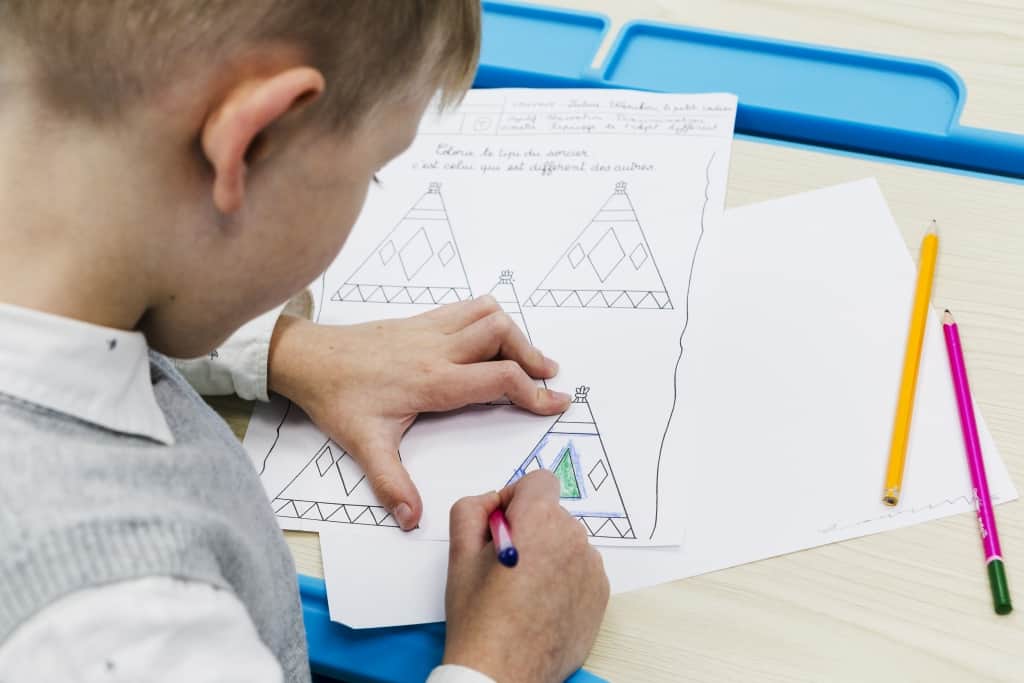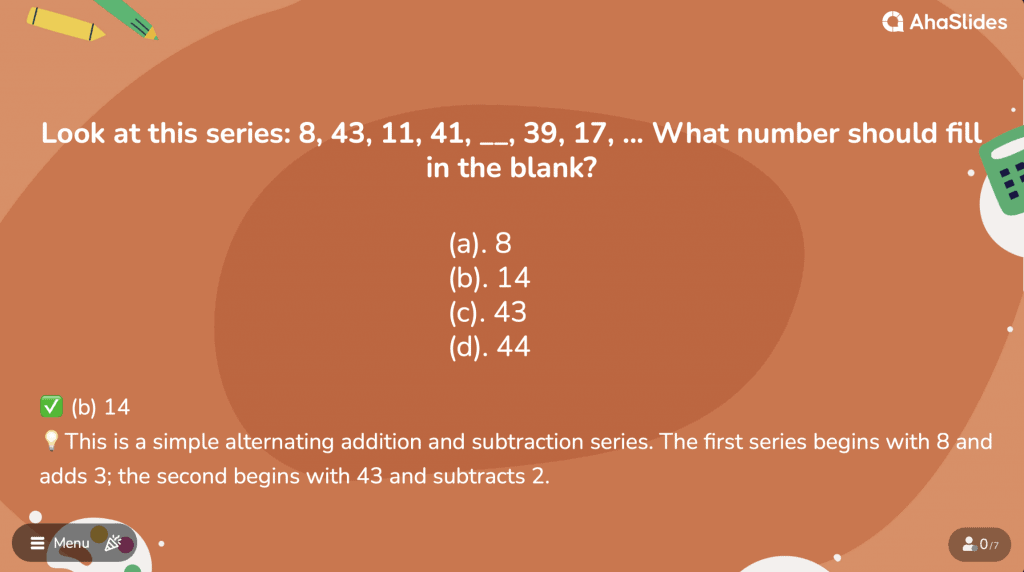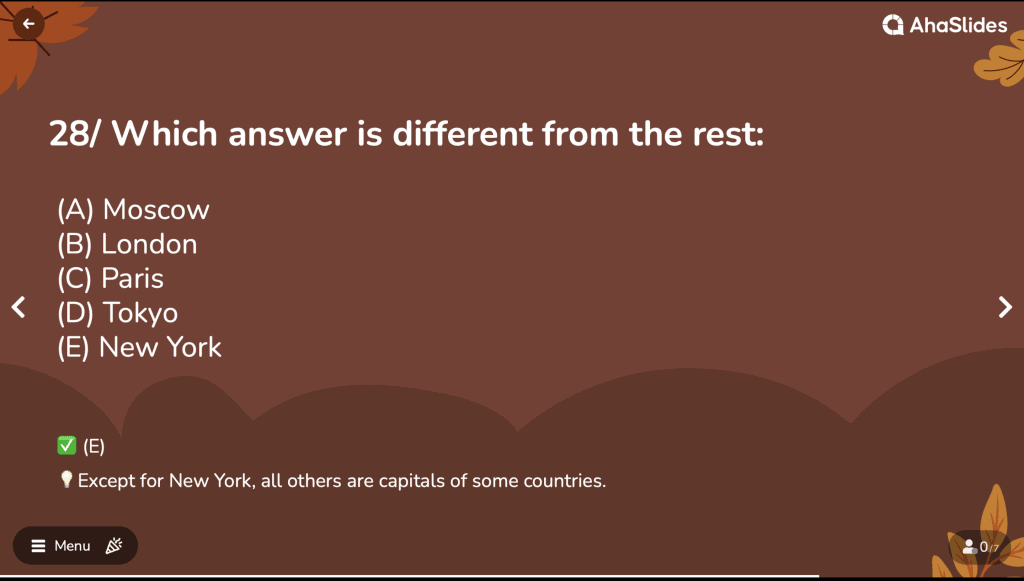Want to know how logical and analytical thinking you are? Let's head over for a test of logical and analytical reasoning questions right now!
This test includes 50 logical and analytical reasoning questions, divided into 4 sections, including 4 aspects: logical reasoning, non-verbal reasoning, verbal reasoning, and deductive vs. inductive reasoning. Plus some analytical reasoning questions in the interview.
Table of Contents
- Logical Reasoning Questions
- Analytical Reasoning Questions - Part 1
- Analytical Reasoning Questions - Part 2
- Analytical Reasoning Questions - Part 3
- More Analytical Reasoning Questions in the Interview
- Frequently Asked Questions

Logical Reasoning Questions
Let's get started with 10 easy logical reasoning questions. And see how logical you are!
1/ Look at this series: 21, 9, 21, 11, 21, 13, 21, ... What number should come next?
a. 14
b. 15
c. 21
d. 23
✅ 15
💡 In this alternating repetition series, the random number 21 is interpolated every other number into an otherwise simple addition series that increases by 2, beginning with the number 9.
2/ Look at this series: 2, 6, 18, 54, ... What number should come next?
a. 108
b. 148
c. 162
d. 216
✅ 162
💡This is a simple multiplication series. Each number is 3 times more than the previous number.
3/ What number should come next? 9 16 23 30 37 44 51 ... ...
a. 59 66
b. 56 62
c. 58 66
d. 58 65
✅ 58 65
💡Here is a simple addition series, which begins with 9 and adds 7.
4/ What number should come next? 21 25 18 29 33 18 ... ...
a. 43 18
b. 41 44
c. 37 18
d. 37 41
✅ 37 41
💡This is a simple addition series with a random number, 18, interpolated as every third number. In the series, 4 is added to each number except 18, to arrive at the next number.
5/ What number should come next? 7 9 66 12 14 66 17 ... ...
a. 19 66
b. 66 19
c. 19 22
d. 20 66
✅ 19 66
💡This is an alternating addition series with repetition, in which a random number, 66, is interpolated as every third number. The regular series adds 2, then 3, then 2, and so on, with 66 repeated after each "add 2" step.
6/ What number should come next? 11 14 14 17 17 20 20 ... ...
a. 23 23
b. 23 26
c. 21 24
d. 24 24
✅ 23 23
💡This is a simple addition series with repetition. It adds 3 to each number to arrive at the next, which is repeated before 3 is added again.

7/ Look at this series: 8, 43, 11, 41, __, 39, 17, ... What number should fill in the blank?
a. 8
b. 14
c. 43
d. 44
✅ 14
💡This is a simple alternating addition and subtraction series. The first series begins with 8 and adds 3; the second begins with 43 and subtracts 2.
8/ Look at this series: XXIV, XX, __, XII, VIII, ... What number should fill the blank?
a. XXII
b. XIII
c. XVI
d. IV
✅ XVI
💡This is a simple subtraction series; each number is 4 less than the previous number.
9/ B2CD, _____, BCD4, B5CD, BC6D. Choose the right answer:
a. B2C2D
b. BC3D
c. B2C3D
d. BCD7
✅ BC3D
💡Because the letters are the same, concentrate on the number series, which is a simple 2, 3, 4, 5, 6 series, and follow each letter in order.
10/ What is the wrong number in this series: 105, 85, 60, 30, 0, - 45, - 90
- 105
- 60
- 0
- -45
✅ 0
💡The correct pattern is - 20, - 25, - 30,..... So, 0 is wrong and must be replaced by (30 - 35) i.e. - 5.
More Tips from AhaSlides
AhaSlides is The Ultimate Quiz Maker
Make interactive games in an instant with our extensive template library to kill boredom

Analytical Reasoning Questions - Part 1
This section is about Non-Verbal Reasoning, which aims to test your ability to analyze graphs, tables, and data, draw conclusions, and make predictions.
11/ Choose the right answer:
✅ (4)
💡This is an alternating series. The first and third segments are repeated. The second segment is simply upside down.
12/ Choose the right answer:
✅ (1)
💡The first segment goes from five to three to one. The second segment goes from one to three to five. The third segment repeats the first segment.
13/ Find out the alternative figure which contains figure (X) as its part.
(X) (1) (2) (3) (4)
✅ (1)
💡
14/ What is the missing item?
✅ (2)
💡A T-shirt is to a pair of shoes as a chest of drawers is to a couch. The relationship shows to which group something belongs. The T-shirt and shoes are both articles of clothing; the chest and cough are both pieces of furniture.
15/ Find the missing part:
✅(1)
💡A pyramid is to triangle as a cube is to square. This relationship shows dimension. The triangle shows one dimension of the pyramid; the square is one dimension of the cube.

16/ Which of the following images is not a replica of the image on the left in the above diagram? Hint: Look at the color of the boxes and their location.
a. A, B, and C
b. A, C, and D
c. B, C, and D
d. A, B, and D
✅ A, C, and D
💡First, look at the color of the boxes and their location to determine which is a replica of the image on the left. We find that B is a replica of the image, so B is excluded as an answer to the question.
17/ Which number is on the face opposite to 6?
a. 4
b. 1
c. 2
d. 3
✅ 1
💡 As the numbers 2, 3, 4, and 5 are adjacent to 6. Hence the number on the face opposite to 6 is 1.
18/ Find out the number that lies inside all the figures.
a. 2 b. 5
c. 9 d. No such number is there
✅ 2
💡Such numbers should belong to all three figures, i.e. circle, rectangle, and triangle. There is only one number, i.e. 2 which belongs to all three figures.
19/ Which one will replace the question mark?
a. 2
b. 4
c. 6
d. 8
✅ 2
💡(4 x 7) % 4 = 7, and (6 x 2) % 3 = 4. Therefore, (6 x 2) % 2 = 6.
20/ Group the given figures into three classes using each figure only once.
a. 7,8,9 ; 2,4,3 ; 1,5,6
b. 1,3,2 ; 4,5,7 ; 6,8,9
c. 1,6,8 ; 3,4,7 ; 2,5,9
d. 1,6,9 ; 3,4,7 ; 2,5,8
✅ 1,6,9 ; 3,4,7 ; 2,5,8
💡1, 6, 9, are all triangles; 3, 4, 7 are all four-sided figures, 2, 5, 8 are all five-sided figures.
21/ Select the alternative that represents three out of the five alternative figures which when fitted into each other would form a complete square.
a. (1)(2)(3)
b. (1)(3)(4)
c. (2)(3)(5)
d. (3)(4)(5)
✅ b
💡
22/ Find out which of the figures (1), (2), (3) and (4) can be formed from the pieces given in figure (X).
✅ (1)
💡
23/ Choose the set of figures which follows the given rule.
Rule: Closed figures become more and more open and open figures become more and more closed.
✅ (2)
24/ Choose a figure that would most closely resemble the unfolded form of Figure (Z).
✅ (3)
25/ Find out from amongst the four alternatives how the pattern would appear when the transparent sheet is folded at the dotted line.
(X) (1) (2) (3) (4)
✅ (1)
Analytical Reasoning Questions - Part 2
In this section, you will be tested to examine your Verbal Reasoning ability, including using written information, and identifying and analyzing key points, to draw conclusions.
26/ Choose the word which is least like the other words in the group.
(A) Pink
(B) Green
(C) Orange
(D) Yellow
✅ A
💡All except Pink are the colors seen in a rainbow.
27/ In the following answers, the numbers given in four out of the five alternatives have some relationship. You have to choose the one which does not belong to the group.
(A) 4
(B) 8
(C) 9
(D) 16
(E) 25
✅ B
💡All other numbers are squares of natural numbers.

28/ Which answer is different from the rest:
(A) Moscow
(B) London
(C) Paris
(D) Tokyo
(E) New York
✅ E
💡Except for New York, all others are capitals of some countries.
29/ "Guitar". Choose the best answer to show their relationship with the given word.
A. band
B. teacher
C. songs
D. strings
✅ D
💡A guitar does not exist without strings, so strings are an essential part of a guitar. A band is not necessary for a guitar (choice a). Guitar playing can be learned without a teacher (choice b). Songs are byproducts of a guitar (choice c).
30/ "Culture". Which following answer is less related to the given word?
- civility
- education
- agriculture
- customs
✅ D
💡A culture is the behavior pattern of a particular population, so customs are the essential element. A culture may or may not be civil or educated (choices a and b). A culture may be an agricultural society (choice c), but this is not the essential element.
31/ "champion". Which following answer is different from the rest
A. running
B. swimming
C. winning
D. Speaking
✅ C
💡 Without a first-place win, there is no champion, so winning is essential. There may be champions in running, swimming, or speaking, but there are also champions in many other areas.
32/ Window is to pane as a book is to
A. novel
B. glass
C. cover
D. page
✅ D
💡A window is made up of panes, and a book is made up of pages. The answer is not (choice a) because a novel is a type of book. The answer is not (choice b) because glass has no relationship to a book. (Choice c) is incorrect because a cover is only one part of a book; a book is not made up of covers.
33/ Lion : flesh : : cow : ……. Fill the blank with the most suitable answer:
A. snake
B. grass
C. worm
D. animal
✅ B
💡 Lions eat flesh, similarly, cows eat grass.
34/ Which of the following is the same as Chemistry, Physics, Biology?
A. English
B. Science
C. Maths
D. Hindi
✅ B
💡Chemistry, Physics, and Biology are part of Science.
35/ Select the option in which the words share the same relationship as that shared by the given pair of words.
Helmet: Head
A. Shirt: Hanger
B. Shoe: Shoe rack
C. Gloves: Hands
D. Water: Bottle
✅ C
💡A helmet is worn on the head. Similarly, gloves are worn on the hands.
36/ Arrange the words given below in a meaningful sequence.
| 1. Police | 2. Punishment | 3. Crime |
| 4. Judge | 5. Judgment |
A. 3, 1, 2, 4, 5
B. 1, 2, 4, 3, 5
C. 5, 4, 3, 2, 1
D. 3, 1, 4, 5, 2
✅ Option D
💡The correct order is: Crime - Police - Judge - Judgment - Punishment
37/ Choose a word that is different from the rest.
A. Tall
B. Huge
C. Thin
D. Sharp
E. Small
✅ D
💡All except Sharp are related to dimension
38/ A Tiebreaker is an additional contest or period of play designed to establish a winner among tied contestants. Which situation below is the best example of a Tiebreaker?
A. At halftime, the score is tied at 28.
B. Mary and Megan have each scored three goals in the game.
C. The referee tosses a coin to decide which team will have possession of the ball first.
D. The Sharks and the Bears each finished with 14 points, and they are now battling it out in a five-minute overtime.
✅ D
💡This is the only choice that indicates that an additional period of play is taking place to determine the winner of a game that ended in a tie.
39/ METAPHOR: SYMBOL. Choose the right answer.
A. pentameter: poem
B. rhythm: melody
C. nuance: song
D. slang: usage
E. analogy: comparison
✅ E
💡A metaphor is a symbol; an analogy is a comparison.
40/ A man walks 5 km toward the south and then turns to the right. After walking 3 km he turns to the left and walks 5 km. Now in which direction is he from the starting place?
A. West
B. South
C. North-East
D. South-West
✅
💡Hence the required direction is South-West.
🌟 You might also like: 100 Fascinating Quiz Questions for Kids to Ignite Their Curiosity
Analytical Reasoning Questions - Part 3
Part 3 comes with the topic of Deductive vs. Inductive Reasoning. It is where you can show your ability to use these two fundamental types of reasoning in different contexts.
- Deductive reasoning is a type of reasoning that moves from general statements to specific conclusions.
- Inductive reasoning is a type of reasoning that moves from specific statements to general conclusions.
41/ Statements: Some kings are queens. All queens are beautiful.
Conclusions:
- (1) All kings are beautiful.
- (2) All queens are kings.
A. The only conclusion (1) follow
B. Only conclusion (2) follows
C. Either (1) or (2) follows
D. Neither (1) nor (2) follows
E. Both (1) and (2) follow
✅ D
💡Since one premise is particular, the conclusion must be particular. So, neither I nor II follow.
42/ Read through the following statements and find out who the CEO is
The car in the first space is red.
A blue car is parked between the red car and the green car.
The car in the last space is purple.
The secretary drives a yellow car.
Alice’s car is parked next to David’s.
Enid drives a green car.
Bert’s car is parked between Cheryl’s and Enid’s.
David’s car is parked in the last space.
A. Bert
B. Cheryl
C. David
D. Enid
E. Alice
✅ B
💡 The CEO drives a red car and parks in the first space. Enid drives a green car; Bert’s car is not in the first space; David’s is not in the first space, but the last. Alice’s car is parked next to David’s, so Cheryl is the CEO.
43/ During the past year, Josh saw more movies than Stephen. Stephen saw fewer movies than Darren. Darren saw more movies than Josh.
If the first two statements are true, the third statement is:
A. true
B. false
C. Uncertain
✅ C
💡Because the first two sentences are true, both Josh and Darren saw more movies than Stephen. However, it is uncertain as to whether Darren saw more movies than Josh.
44/ Pointing to a photograph of a boy Suresh said, "He is the only son of my mother." How is Suresh related to that boy?
A. Brother
B. Uncle
C. Cousin
D. Father
✅ D
💡The boy in the photograph is the only son of the son of Suresh's mother i.e., the son of Suresh. Hence, Suresh is the father of a boy.
45/ Statements: All the pencils are pens. All the pens are inks.
Conclusions:
- (1) All the pencils are ink.
- (2) Some inks are pencils.
A. Only (1) conclusion follows
B. Only (2) conclusion follows
C. Either (1) or (2) follows
D. Neither (1) nor (2) follows
E. Both (1) and (2) follow
✅ E
💡
46/ Since all humans are mortal, and I am human, then I am mortal.
A. Deductive
B. Inductive
✅ A
💡In deductive reasoning, we start with a general rule or principle (all humans are mortal) and then apply it to a specific case (I am a human). The conclusion (I am mortal) is guaranteed to be true if the premises (all humans are mortal and I am a human) are true.
47/ All chickens that we have seen have been brown; so, all chickens are brown.
A. Deductive
B. Inductive
✅ B
💡The specific observations are that "all chickens that we have seen have been brown." The inductive conclusion is "all chickens are brown," which is a generalization drawn from specific observations.
48/ Statements: Some pens are books. Some books are pencils.
Conclusions:
- (1) Some pens are pencils.
- (2) Some pencils are pens.
- (3) All pencils are pens.
- (4) All books are pens.
A. Only (1) and (3)
B. Only (2) and (4)
C. All the four
D. None of the four
E. Only (1)
✅ E
💡
49/ All crows are black. All blackbirds are loud. All crows are birds.
Statement: All crows are loud.
A. True
B. False
C. Insufficient information
✅ A
50/ Mike finished ahead of Paul. Paul and Brian both finished before Liam. Owen did not finish last.
Who was the last to finish?
A. Owen
B. Liam
C. Brian
D. Paul
✅ B
💡 The order: Mike finished before Paul, so Mike was not last. Paul and Brian finished before Liam, so Paul and Brian were not last. It is stated that Owen did not finish last. Only Liam remains, so Liam must have been last to finish.

Looking for Interactive Presentations?
Gather your team members by a fun quiz on AhaSlides. Sign up to take free quiz from AhaSlides template library!
🚀 Grab Free Quiz☁️
More Analytical Reasoning Questions in the Interview
Here are some bonus Analytical Reasoning Questions for you if you are going to be in an interview. You can prepare the answer beforehand and good luck!
51/ How do you use advantages and disadvantages to make a decision?
52/ How would you come up with a solution to identify plagiarism?
53/ Describe a time when you had a problem with little information. How did you handle that situation?
54/ In your experience, would you say that developing and using a detailed procedure was always necessary for your job?
55/ What goes into your decision-making process at work?
🌟 Want to create your own quiz? Sign up for AhaSlides and get free beautiful and customizable quiz templates at any time.
Frequently Asked Questions
What are Analytical Reasoning questions?
Analytical Reasoning (AR) questions are designed to examine your ability to arrive at a logical conclusion or solution to given problems. The answers, due to a group of facts or rules, use those patterns to determine outcomes that could be or must be true.AR questions are presented in groups, with each group based on a single passage.
What are examples of Analytical Reasoning?
For instance, it is correct to say that "Mary is a bachelor." Analytical reasoning allows one to conclude that Mary is single. The name "bachelor" implies the state of being single, thus one knows this to be true; no particular understanding of Mary is necessary for reaching this conclusion.
What is the difference between logical and analytical reasoning?
Logical reasoning is the process of following logical thought step by step to achieve a conclusion, and it can be tested in a variety of ways, from inductive and deductive reasoning to abstract reasoning. Analytical reasoning is the process of analyzing the logic required to obtain a conclusion that could or must be true.
How many questions are on Analytical Reasoning?
The Analytical Reasoning Test evaluates your capacity for analysis, problem-solving, and logical and critical thought. The majority of analytical reasoning tests are timed, with 20 or more questions and 45 to 60 seconds allowed per question.
Resource: Indiabix | Psychometric success | Indeed








